Pecharsky V.K., Zavalij P.Y. Fundamentals of Powder Diffraction and Structural Characterization of Materials
Подождите немного. Документ загружается.

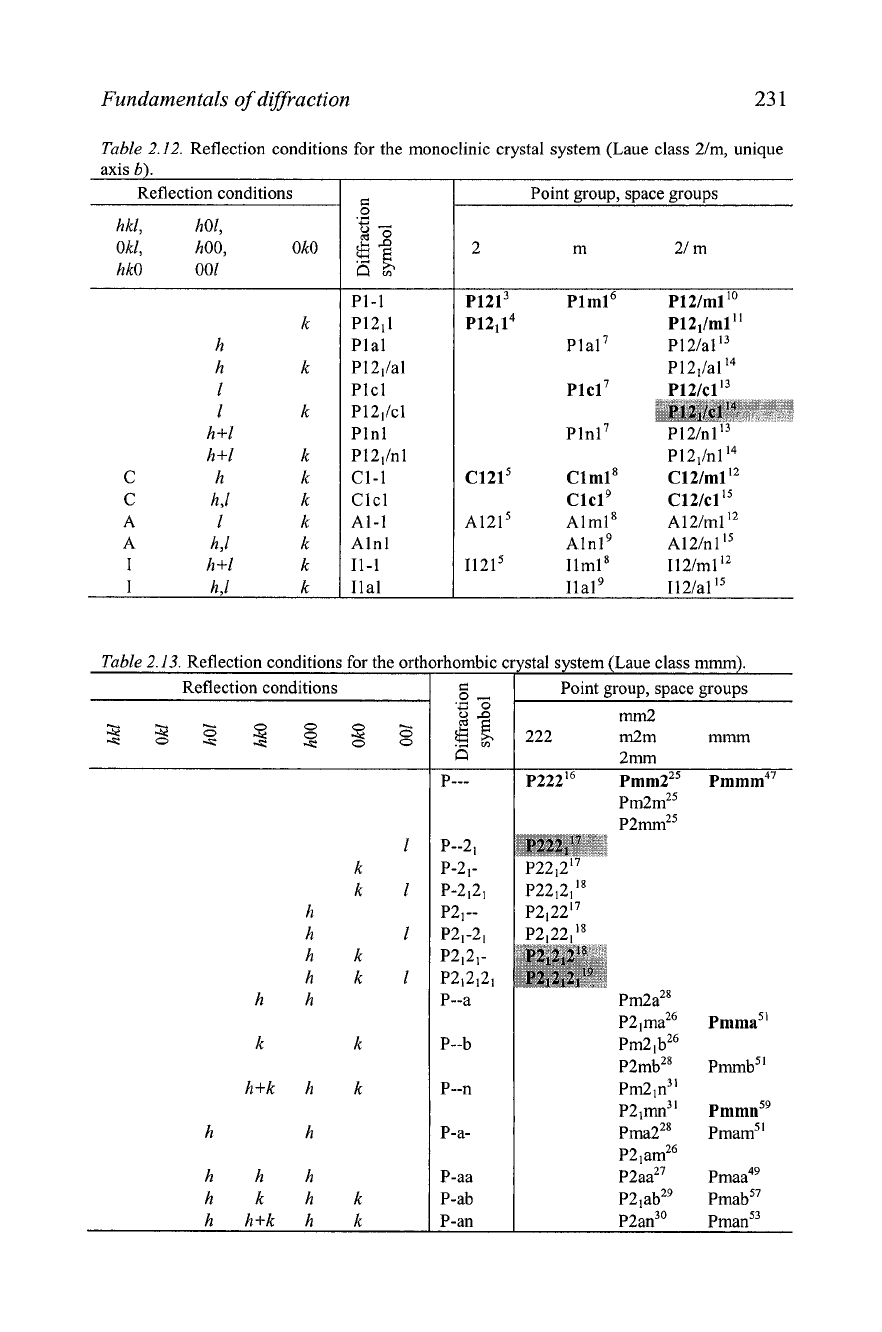
Fundamentals
of
diffraction
23
1
Table
2.12.
Reflection conditions for the monoclinic crystal system (Laue class 2/m, unique
axis
b).
Reflection conditions
hkl, h01,
Okl, hOO, OkO
hkO 001
8
'C
2
5
'I
n
v,
PI-l
PI211
Plal
P12,Ial
Plcl
P12'/~l
Plnl
P121/nl
CI-l
Clcl
Al-l
Alnl
11-1
Ilal
Table
2.13.
Reflection conditions for the ortl
Reflection conditions
h
h
h
h
hh
k
h+k h
h h
hhh
hkh
Point group, space groups
rhombic
G
.o"
s
a
P--21
P-2'-
P-2'2'
P2'--
P2'-2'
P2'2,-
p212121
P--a
P--b
P--n
P-a-
P-aa
P-ab
P-an
Point group, space groups
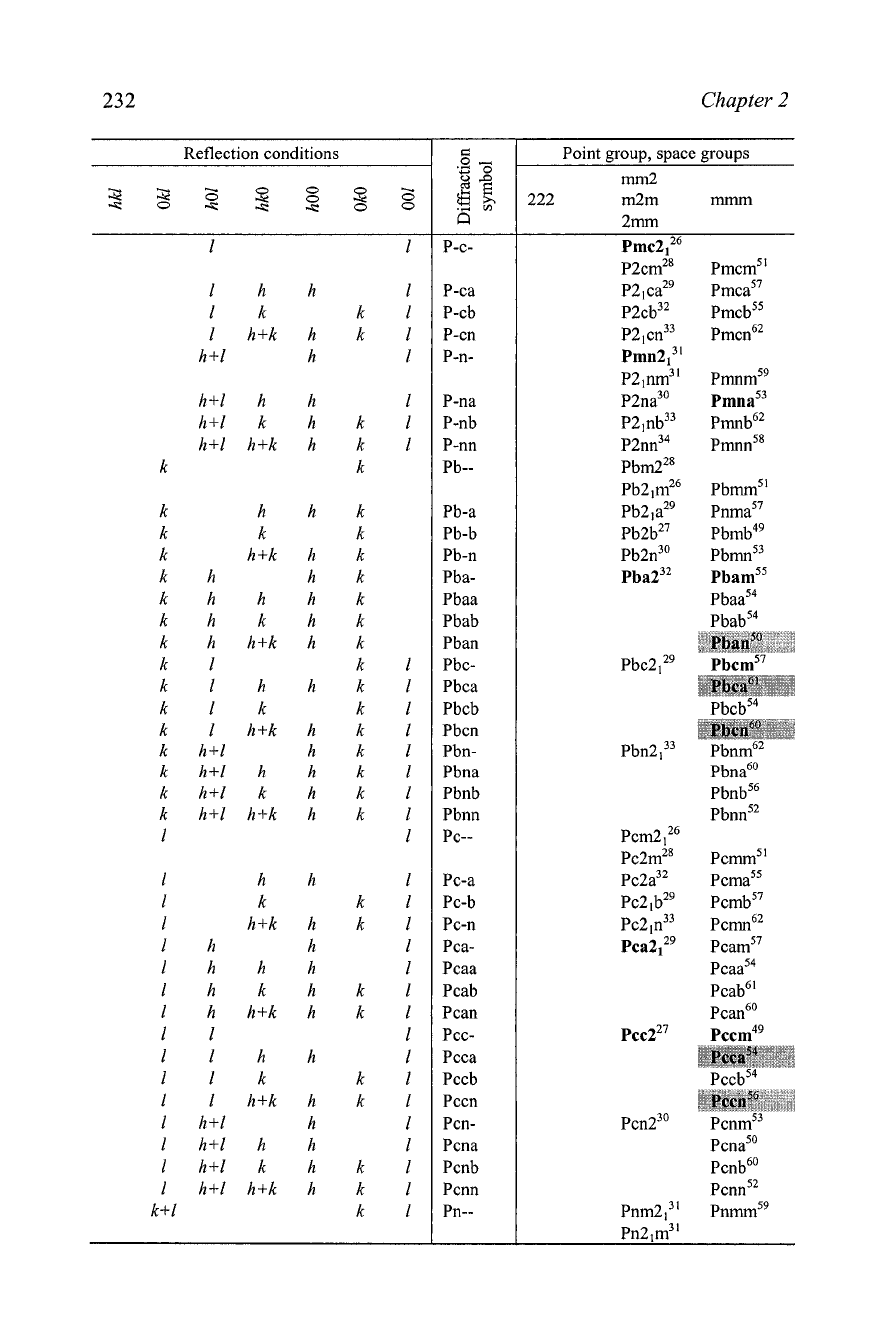
232
Chapter 2
Reflection conditions
C
lhh
1
1
k k
1
1
h+k h k
1
h+l h
1
k hhk
k k k
k h+k h k
kh hk
khhhk
khkhk
k h h+k h k
k
1
k
1
klhhkl
klk k
1
k lh+kh k
1
k h+l hkl
kh+lh h k
1
kh+lk
h
k
I
k h+l h+k h k
1
1 1
1
hh
1
1
k k
1
1
h+k h k
1
1 h h
1
lhhh
1
lhkhkl
1
hh+kh k
1
11
1
llhh
1
Ilk k
1
1
lh+kh k
1
1
h+l h
1
1
h+l h h
1
lh+lk h k
1
1
h+l h+k h k
1
k+l k
1
P-c-
P-ca
P-cb
P-cn
P-n-
Pb-a
Pb-b
Pb-n
Pba-
Pbaa
Pbab
Pban
Pbc-
Pbca
Pbcb
Pbcn
Pbn-
Pbna
Pbnb
Pbnn
PC--
PC-a
PC-b
PC-n
Pca-
Pcaa
Pcab
Pcan
Pcc-
Pcca
Pccb
Pccn
Pcn-
Pcna
Pcnb
Pcnn
Pn--
Point group, space groups
mrn2
222
m2m
mmm
2mm
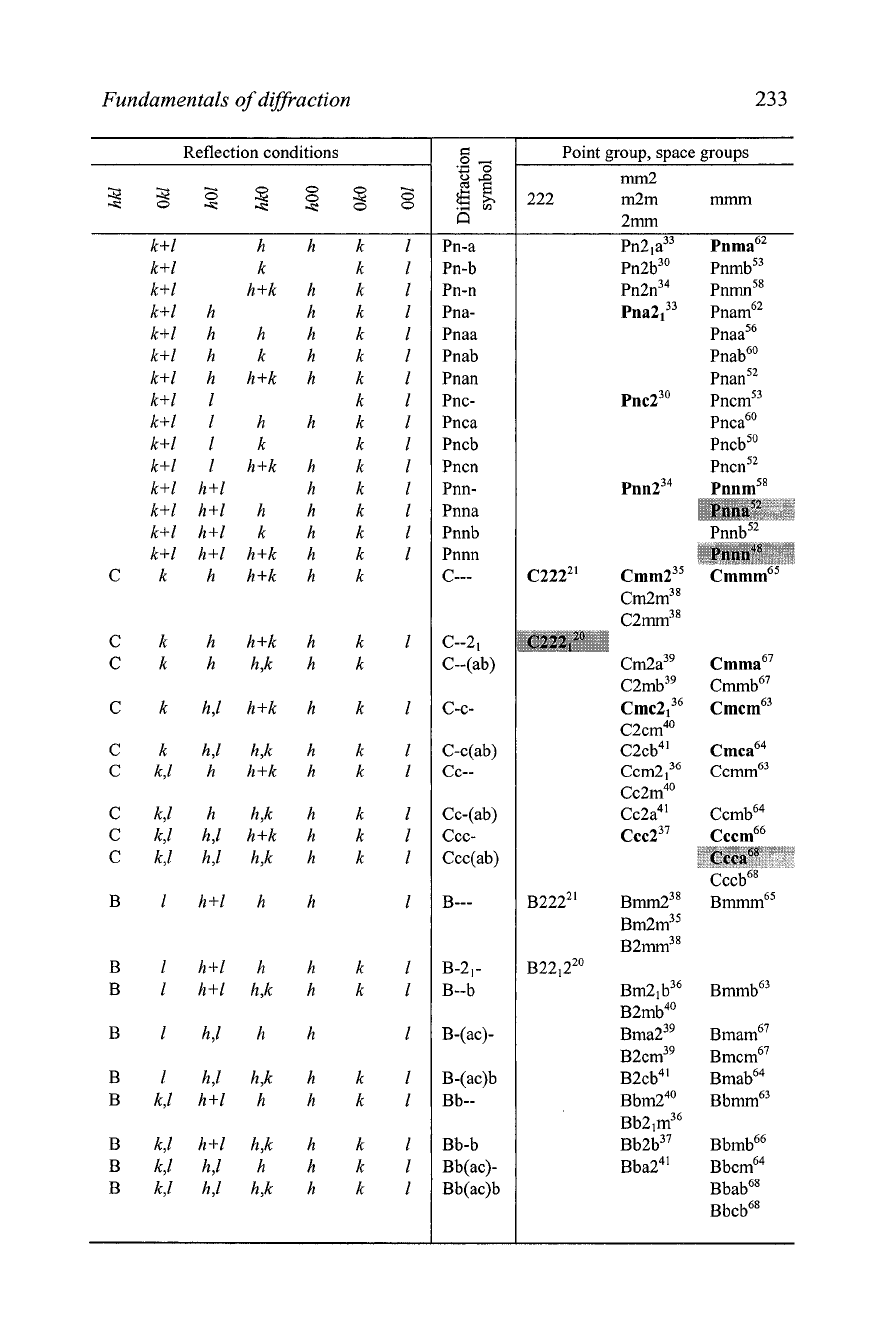
Fundamentals of diffraction
233
Reflection conditions
I
Point group, space groups
2mm
k+l hhkl
k+l k k
1
k+l h+k h
k
1
k+l h hkl
k+lh h h k
1
k+lh k h k
1
k+l h h+k h k
1
k+l
1
k
1
k+l
1
h
h
k
1
k+l
1
k k
1
k+l
1
h+k h k
1
k+l h+l hkl
k+l h+l h h k
1
k+l h+l k h k
I
k+l h+l h+k h k
1
k h h+k h k
Pn-a
Pn-b
Pn-n
Pna-
Pnaa
Pnab
Pnan
Pnc-
Pnca
Pncb
Pncn
Pnn-
Pnna
Pnnb
Pnnn
c---
~222~' ~mm2~~ Cmmm
~m2rn~~
C-c-
Cc-(ab)
Ccc-
Ccc(ab)
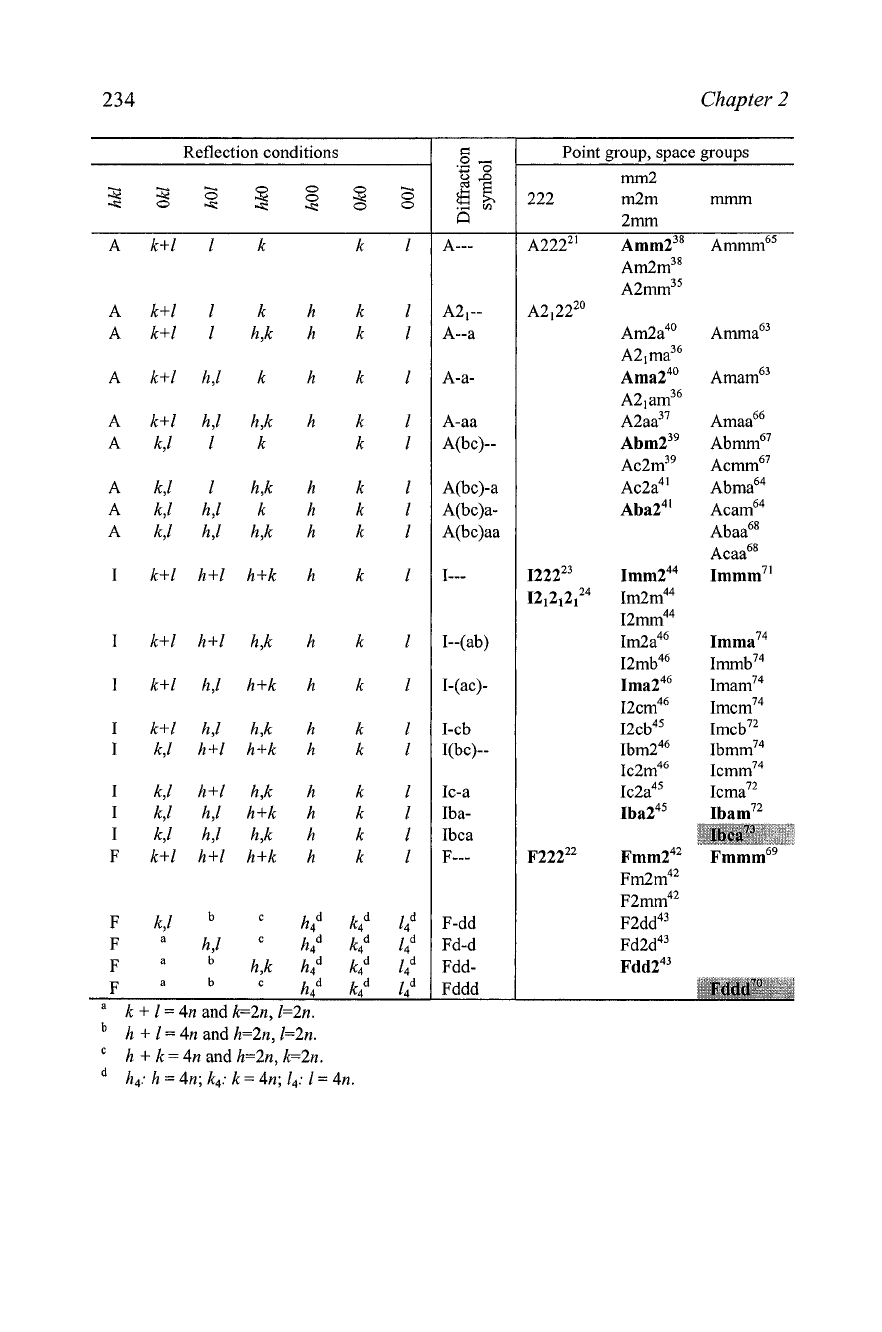
234
Chapter
2
1
hqd kqd
$
i-dd
a
h,l hqd kqd
Fd-d
a
h,k hqd kqd lqd
~dd-
F
a
hqd kqd
1:
Fddd
a
k
+
1
=
4n and k=2n, 1=2n.
h
+
1
=
4n and h=2n, 1=2n.
h
+
k
=
4n and h=2n, k=2n.
h4:
h
=
4n; k4:
k
=
4n;
14: 1
=
4n.
I
k,l
h+l
h,k h k
1
I
k,l
h,l h+k h k
1
I
k,l
h,l
h,k h k
1
F
k+l h+l
h+k
h
k
1
Point group, space groups
mrn2
222 m2m
rnmrn
2mm
I
~222~' ~rnrn2~~ Amrnd5
~m2rn~~
~2mm~~
~2~22"
Am2a40 ~rnrna~~
~2~ma~~
~rna2~' ~mam~~
~2,arn~~
~2aa~~
~brn2~~ ~bmm~~
~c2rn~~ ~cmm~~
Ac2a4' ~bma~~
~ba2~'
cam^^
Abaa6*
Acaa6'
1222'~ 1rnrn2~~ 1rnrnrn7'
12~2~2~~~ 1m2m~~
12mm~~
1m2a~~ ~rnrna~~
12~b~~ ~~b~~
1rna2~~
12cm~~ ~mcrn'~
12cb~~ 1mcb7'
1brn2~~ ~bmm~~
1c2rn~~ ~cmrn~~
1c2a~~ ~cma~~
1ba2~' 1barn7'
~222~' ~rnrn2~~
~m2m~~
~2rnm~~
~2dd~~
~d2d~~
Ic-a
Iba-
Ibca
F---
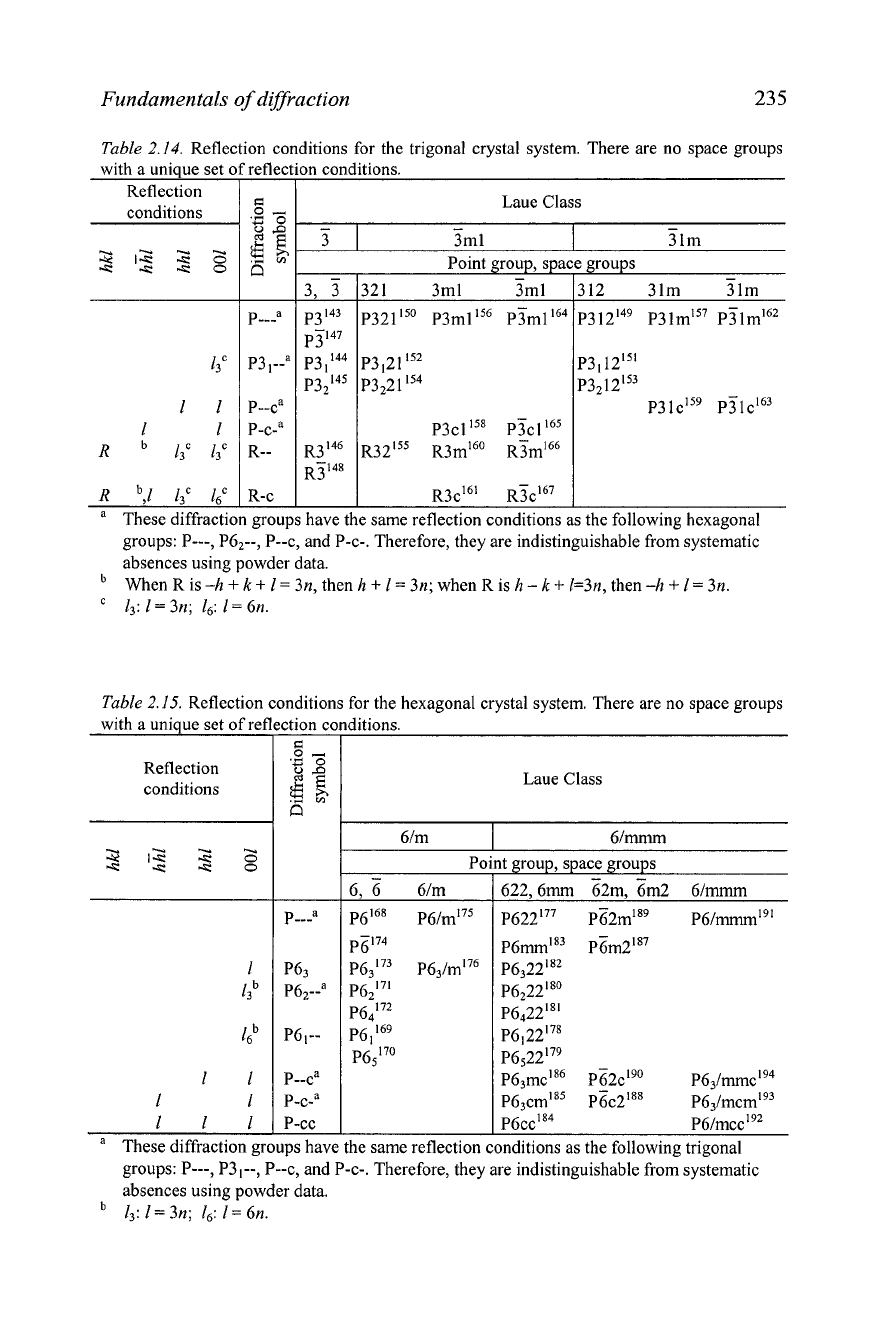
Fundamentals of diffraction
235
Table
2.14.
Reflection conditions for the trigonal crystal system. There are no space groups
with a unique set
(
Reflection
conditions
reflection conditions.
I
R
b,l 13~
12
I
a
These diffraction groups have
r
-
:
groups
-
312 31m 31m
~3 12'~~ ~3 lmIs7 ~31m'~~
:
same reflection conditions as the following hexagonal
3,
3
I
C
0
3
.
-
4-
0
i5
*
-.
:h<
- -
groups:
P---,
P62--, P--c, and P-c-. Therefore, they are indistinguishable from systematic
absences using powder data.
~en~is-h+k+1=3n,thenh+l=3n;when~ish-k+l=3n,then-h+1=3n.
13:
1
=
3n; 16: 1
=
6n.
Laue Class
Table
2.15.
Reflection conditions for the hexagonal crystal system. There are no space groups
- -
3
I
3ml
with a unique set of ref
-
31m
Reflection
conditions
Point group, spact
ction cc
c
,s
z
P
@
8
n
p---a
P63
P62--a
P6!--
P--ca
P-c-~
P-cc
Laue Class
t group, space groups
622,6mm 62m, 6m2 6lmmm
P~cc'~~
~61mcc'~~
a
These diffraction groups have the same reflection conditions as the following trigonal
groups: P---, P3'--, P--c, and P-c-. Therefore, they are indistinguishable from systematic
absences using powder data.
13: 1
=
3n;
4:
1
=
6n.
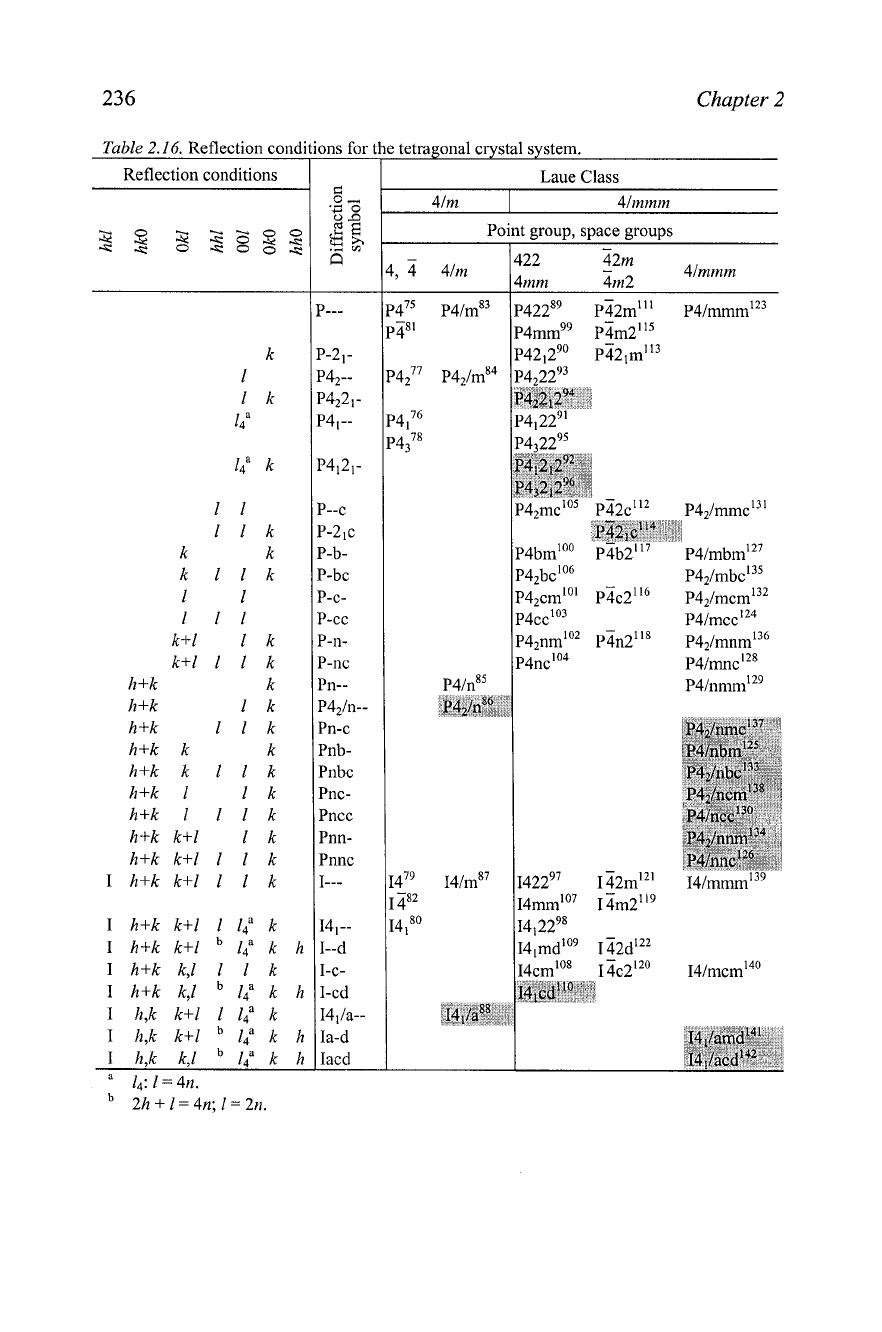
Chapter
2
Table
2.16.
Reflection condi
Reflection conditions
I
h+k k+l
1 1:
k
I
h+k k+l lqa k
I
h+k k,l
11
k
I
h+k k,l
1:
k
I
h,k k+l
1 1:
k
I
h,k k+l
L"
k
)---
'-2'-
'42--
'422'-
'4'--
'4121-
LC
'-2'c
3-b-
'-bc
LC-
='-cc
?-n-
?-nc
Pn--
P42/n--
Pn-c
Pnb-
Pnbc
Pnc-
Pncc
Pnn-
Pnnc
[---
I4'--
I--d
I-c-
I-cd
14'/a--
Ia-d
Iacd
tetragonal crystal system.
Laue Class
4lm 4/mmm
Point group, space groups
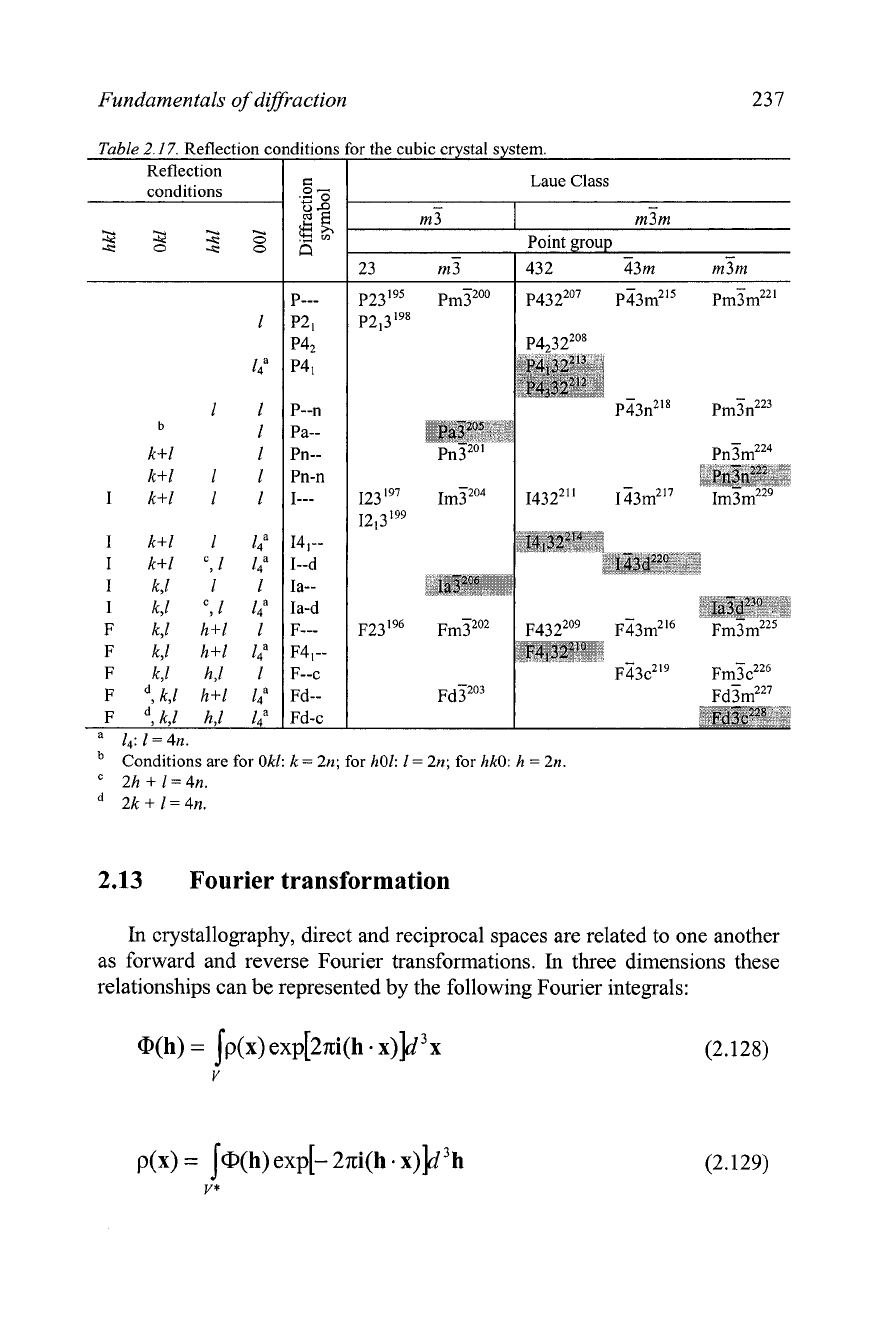
Fundamentals
of
diffraction
237
Table
2.17.
Reflection cc
Reflection
conditions
F
d,
k,l h,l lda
a
la:
1
=
4n.
ditions
e
0-
.;
0
0s
4
g
8
p---
p2
1
p42
p4
1
P--n
Pa--
Pn--
Pn-n
I---
I4,--
I--d
Ia--
Ia-d
F---
F4
--
F--C
Fd--
Fd-c
Point group
-
23 m3
1
432 43m m3m
r the cubic crystal system.
Laue Class
Conditions are for
Okl: k
=
2n; for
h01:
1
=
2n; for
hkO:
h
=
2n.
'
2h+l=4n.
2k+l=4n.
m7
2.13
Fourier transformation
m3m
In
crystallography, direct and reciprocal spaces are related to one another
as forward and reverse Fourier transformations.
In
three dimensions these
relationships can be represented by the following Fourier integrals:
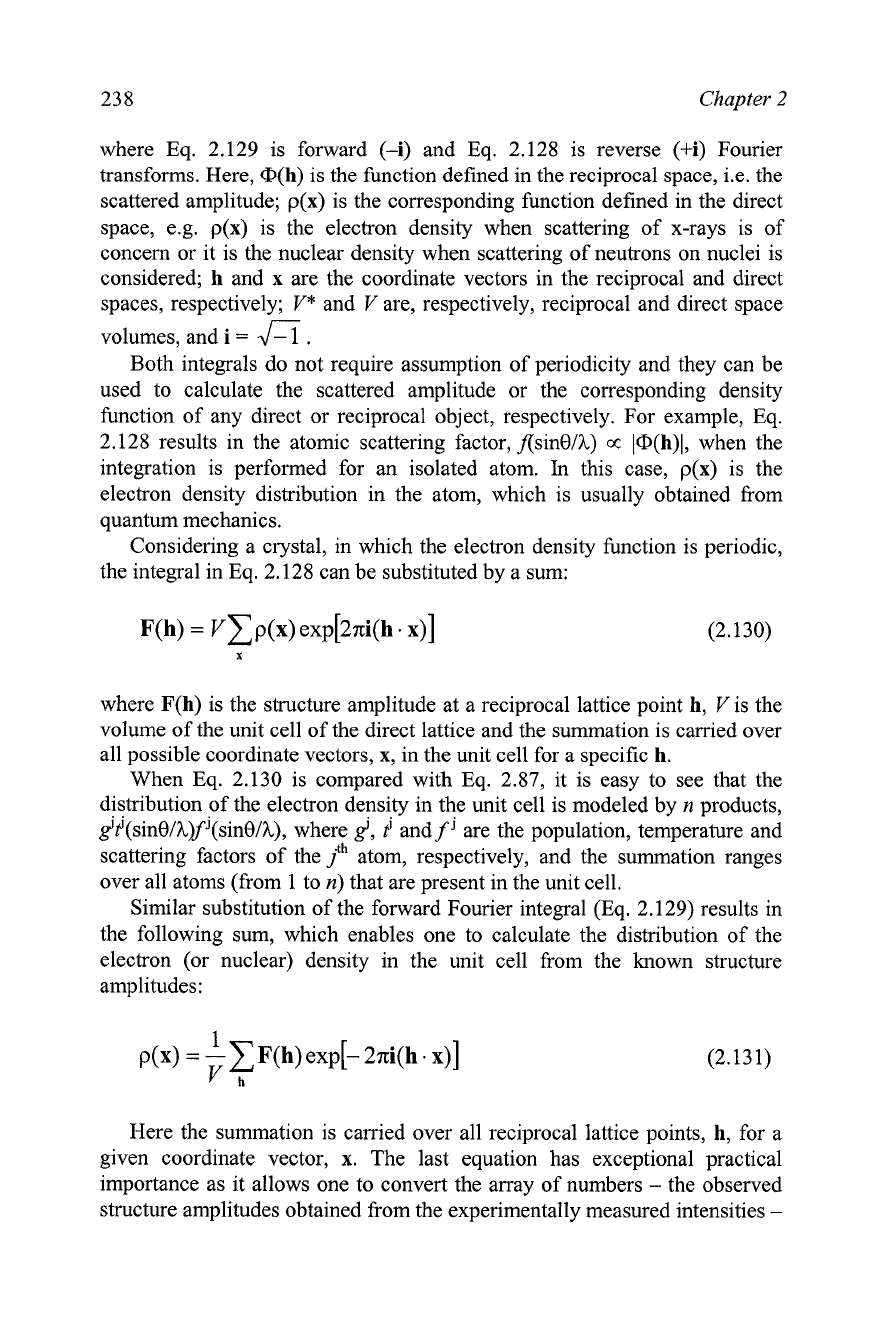
23 8
Chapter 2
where Eq. 2.129 is forward (-i) and Eq. 2.128 is reverse (+i) Fourier
transforms. Here, @(h) is the function defined in the reciprocal space, i.e. the
scattered amplitude; p(x) is the corresponding function defined in the direct
space, e.g. p(x) is the electron density when scattering of x-rays is of
concern or it is the nuclear density when scattering of neutrons on nuclei is
considered; h and x are the coordinate vectors in the reciprocal and direct
spaces, respectively;
V*
and
V
are, respectively, reciprocal and direct space
volumes, and
i
=
fi
.
Both integrals do not require assumption of periodicity and they can be
used to calculate the scattered amplitude or the corresponding density
function of any direct or reciprocal object, respectively. For example, Eq.
2.128 results in the atomic scattering factor,
flsinelh)
cc
I@(h)l, when the
integration is performed for an isolated atom.
In
this case, p(x) is the
electron density distribution in the atom, which is usually obtained from
quantum mechanics.
Considering a crystal, in which the electron density function is periodic,
the integral in Eq. 2.128 can be substituted by a sum:
F(h)
=
v
p(x)
exp[2ni(h
.
x)]
X
where P(h) is the structure amplitude at a reciprocal lattice point h,
V
is the
volume of the unit cell of the direct lattice and the summation is carried over
all possible coordinate vectors, x, in the unit cell for a specific h.
When Eq. 2.130 is compared with Eq. 2.87, it is easy to see that the
distribution of the electron density in the unit cell is modeled by
n products,
g'P(sinelhlfJ(sinelh), where
g',
P
and
f
j
are the population, temperature and
scattering factors of the
jth
atom, respectively, and the summation ranges
over all atoms (from 1 to n) that are present in the unit cell.
Similar substitution of the forward Fourier integral (Eq. 2.129) results in
the following sum, which enables one to calculate the distribution of the
electron (or nuclear) density in the unit cell from the known structure
amplitudes:
1
p(x)
=
-
~(h) exp[- 2ni(h
.
x)]
v
h
Here the summation is carried over all reciprocal lattice points, h, for a
given coordinate vector,
x.
The last equation has exceptional practical
importance as it allows one to convert the array of numbers
-
the observed
structure amplitudes obtained from the experimentally measured intensities
-
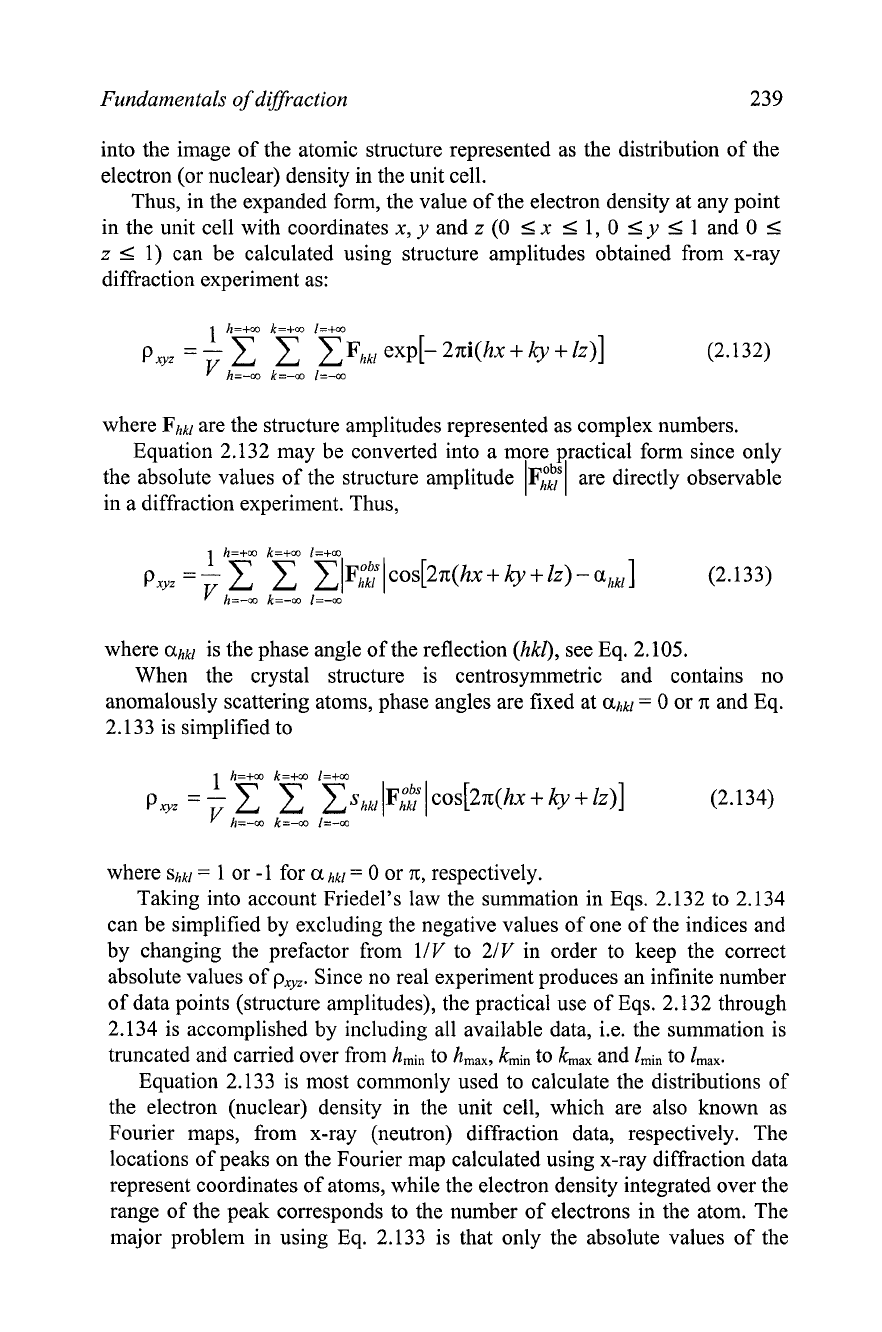
Fundamentals
of
dzgraction
239
into the image of the atomic structure represented as the distribution of the
electron (or nuclear) density in the unit cell.
Thus, in the expanded form, the value of the electron density at any point
in the unit cell with coordinates x,
y
and
z
(0
5
x
5
1, 0
5
y
5
1 and
0
5
z
I
1) can be calculated using structure amplitudes obtained from x-ray
diffraction experiment as:
where
Fhkl
are the structure amplitudes represented as complex numbers.
Equation 2.132 may be converted into a more practical form since only
the absolute values of the structure amplitude
IF;;~
are directly observable
in a diffraction experiment. Thus,
1
h=+m
k=+m l=+m
=
-
z z
zlFi;lcos[2n(hx
+
ky
+
lz)
-
(2.133)
Pm
v
,,=* ,'=-a l=-m
where
ahkl
is the phase angle of the reflection
(hkl),
see Eq. 2.105.
When the crystal structure is centrosymmetric and contains no
anomalously scattering atoms, phase angles are fixed at
ahkl=
0 or
n
and Eq.
2.133 is simplified to
where
shkl=
1 or -1 for
a
hkl=
0 or
n,
respectively.
Taking into account Friedel's law the summation in Eqs. 2.132 to 2.134
can be simplified by excluding the negative values of one of the indices and
by changing the prefactor from 1/V to 2/V in order to keep the correct
absolute values of
pxyz.
Since no real experiment produces an infinite number
of data points (structure amplitudes), the practical use of Eqs. 2.132 through
2.134 is accomplished by including all available data, i.e. the summation is
truncated and carried over from
hmin
to
hmax, kmin
to
kmax
and
lmin
to
Imax.
Equation 2.133 is most commonly used to calculate the distributions of
the electron (nuclear) density in the unit cell, which are also known as
Fourier maps, from x-ray (neutron) diffraction data, respectively. The
locations of peaks on the Fourier map calculated using x-ray diffraction data
represent coordinates of atoms, while the electron density integrated over the
range of the peak corresponds to the number of electrons in the atom. The
major problem in using Eq. 2.133 is that only the absolute values of the
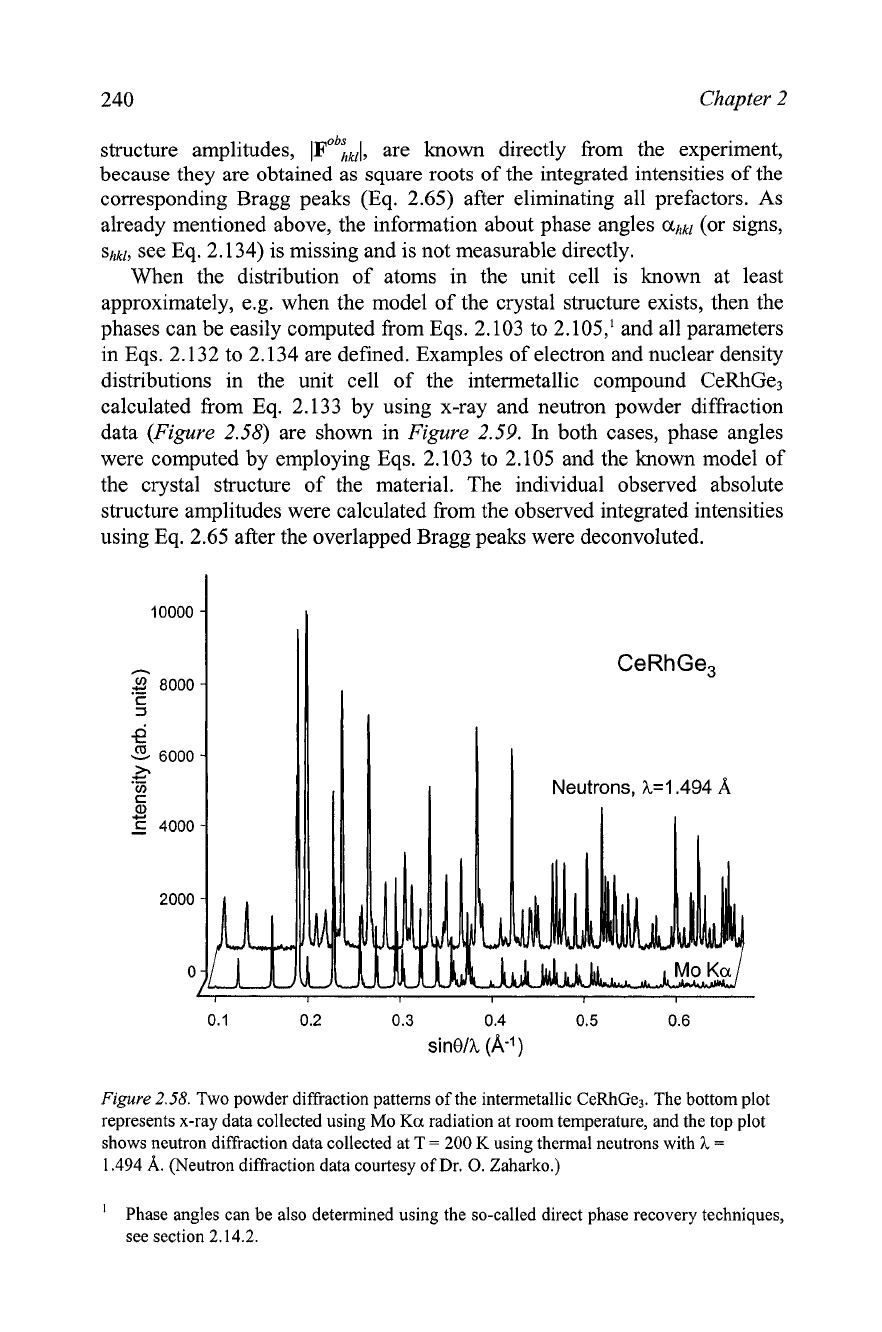
240 Chapter 2
structure amplitudes,
IF"^;,^,
are known directly from the experiment,
because they are obtained as square roots of the integrated intensities of the
corresponding Bragg peaks (Eq. 2.65) after eliminating all prefactors. As
already mentioned above, the information about phase angles
ahkl
(or signs,
shkl, see Eq. 2.134) is missing and is not measurable directly.
When the distribution of atoms in the unit cell is known at least
approximately,
e.g. when the model of the crystal structure exists, then the
phases can be easily computed from Eqs. 2.103 to 2.105,' and all parameters
in Eqs. 2.132 to 2.134 are defined. Examples of electron and nuclear density
distributions in the unit cell of the intermetallic compound
CeRhGe3
calculated from Eq. 2.133 by using x-ray and neutron powder diffraction
data (Figure 2.58) are shown in Figure 2.59.
In
both cases, phase angles
were computed by employing Eqs. 2.103 to 2.105 and the known model of
the crystal structure of the material. The individual observed absolute
structure amplitudes were calculated from the observed integrated intensities
using Eq. 2.65 after the overlapped Bragg peaks were deconvoluted.
Neutrons,
h=1.494
A
Figure
2.58.
Two powder diffraction patterns of the intermetallic CeRhGe3. The bottom plot
represents x-ray data collected using Mo
Ka
radiation at room temperature, and the top plot
shows neutron diffraction data collected at T
=
200
K
using thermal neutrons with
h
=
1.494
A.
(Neutron diffraction data courtesy of Dr.
0.
Zaharko.)
'
Phase angles can be also determined using the so-called direct phase recovery techniques,
see section 2.14.2.
